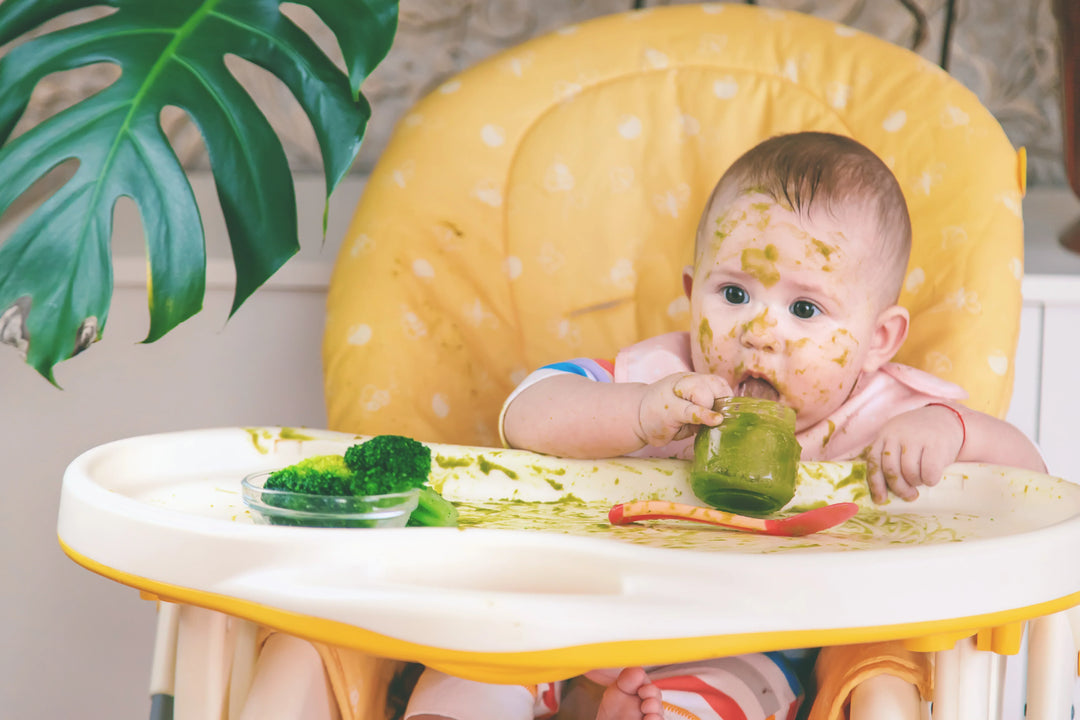Starting Solids Without Distractions: Keep Your Baby Engaged during Mealtime

Have you ever wondered how long your baby should be able to sit at the table? You are not alone! A lot of families come to me stressed that their baby is not doing “enough.” Some worry their baby’s attention span is too short, while others hope that longer mealtimes will mean more food gets eaten.
The truth is, baby mealtime engagement isn’t about minutes on a clock. A child who is distracted or bored won’t necessarily eat more just because they stay seated longer. What matters is creating mealtimes that feel calm, connected, and engaging. There are a lot of positive things we can do to engage our little ones at the table that we want to share with you today!
How long can babies stay engaged at the table?
There isn’t a single “official” standard by exact minute of how long your little one should be at the table, but there are general recommendations based on their attention span by age and feeding research. Here is what you might be able to expect:
Baby attention span during meals by age
-
6-12 months: 10-15 minutes
-
12-24 months: 10-15 minutes
-
2-3 years: 15-20 minutes
If your child is not sitting or engaged for that long, do not fret! Let’s talk about ways to engage them at the table.
Setting your baby up for keeping baby engaged at the table
First, set them up for success by figuring out their optimal mealtimes. You want them to come to the table hungry, happy, and alert.
Try to find a gap between when they last bottle or breastfed, and when you are going to offer solids, so that they are starting to get hungry. Additionally, you want to ensure they are not so tired that they are about to become fussy.
Finding the right time might take a little bit of trial and error, and typically it does change over time since your baby’s nap and feeding schedule is always evolving (predictability really goes out the window once you have kids!).
Finding a mealtime rhythm that works for your family
Here is a sample schedule based on age so you don’t have to do this alone!

Once you have a good working schedule, aim to maintain that short, predictable mealtime as much as possible. Just like adults, once you have a schedule in place (even if it's a little loose), your baby will likely get used to being fed at that time!
Simple, screen-free ways to keep babies engaged at meals

Modeling: letting your baby learn by watching you
-
Model eating – simple, but so effective! Babies love to watch their family members, and this is the best way they can learn to eat! Even if they aren’t consuming much yet, it is so beneficial to eat alongside them!
Food engagement: songs, talk, and playful exploration
-
Sing songs – keep things silly and fun! Sing your baby’s favorite songs while they eat or make up ones about the food they are eating. You might surprise yourself with some clever rhymes ☺ (squash, wash, posh).
-
Talk about your food (color, shape, smell, sound, etc.) – I know this might sound unnecessary when your baby may not even be talking yet, but trust me, they are always learning from you! Not only is this a way to engage them with food, but it is also a great foundation to help your little one be comfortable around new foods when they are older!
-
Help them explore – model or provide hand-over-hand to get messy with their food. Check out why this is so amazing for your little one.
-
Play peek-a-boo with food items or your napkin! Sometimes I even like to hide under the tray for a second!
Routines and little cues that keep babies focused
-
Add predictable cues – You can start the meal with the same song, sound or “cheers” with a cup. You can use a consistent phrase to end the meal (“All done,” or “Thank you for eating with me!”). Predictability can help keep little ones focused.
-
Offer age-appropriate utensils – Give your baby spoons, forks, or cups to play or practice with so they are really involved in the meal. This not only keeps them interested in the meal but is great for self-feeding.
Extra support for keeping baby engaged at the table
-
Read at the table – incorporate books about food or eating when possible! One of my personal favorites is The Very Hungry Caterpillar.
-
Use preferred toys – Invite a favorite stuffed animal to eat with you, or bring the food across the table on a little tractor or car. Mealtimes are supposed to be fun!
-
Optimize your feeding equipment – Use seating with good support. Research shows that having a stable feeding posture improves participation.
Reducing distractions at baby mealtimes
One of the most effective strategies for baby mealtime engagement is reducing distractions:
-
Remove distracting toys
-
Turn off the TV
-
Keep the focus on food and family connection
I find this piece SO important, I think we should dive into it more!

Screens at the table: what parents should know
Let’s talk about screen time at the table. I know it’s tempting. You might want to put on the TV or iPad while your child is in their high chair and eating, so that you can get some things done around the house. (As a quick safety note, please always be watching/in the room with your child while eating in case of an emergency.)
Or maybe you think the screen will be just distracting enough that your little one will enjoy being in their highchair more and will even eat more than they typically do. I completely understand the appeal, but here are the reasons I try to avoid it at the table as much as possible.
Why screens can get in the way of mealtime engagement
There is strong evidence that screens during mealtimes, especially for young children, are problematic. They lead to:
-
Poorer dietary habits and increased junk food intake.
-
Obesity and overeating risk – screens actually distract children from recognizing fullness. As a result, they can lead to overeating and set up a foundation for unhealthy weight gain over time.
-
Children eating mechanically and missing out on important sensory experiences, such as smell, texture, and taste. They aren’t focused on what is really important – the food!
-
Less responsive feeding – caregivers misreading or misunderstanding their child’s hunger and satiety cues.
-
Decreased social interactions at meals and missing out on potential bonding as a family.
As a mother of two, I also occasionally use screens. There is no judgment from me! I would just suggest using them outside of meal times if you want to use them.
Screen time guidelines for babies and toddlers
These are the current general screen time recommendations from the American Academy of Pediatrics (AAP) and the World Health Organization (WHO).
-
Under 18 months: no screen time (except video chatting with family/caregivers)
-
18–24 months: if parents choose to introduce screen use, only high-quality, age-appropriate programming and co-view with your child so that the interaction is shared and no passive watching
-
2–5 years: limit to about 1 hour per day, with high-quality content. Co-viewing is still encouraged to help children connect what they see with the real world.
Starting healthy mealtime habits for keeping baby engaged
My philosophy, which I always share with parents, is that it is easier never to introduce a screen at meal times than to use one and then try to take it away.
If you focus on engagement at the table from the start of your child’s eating journey, rather than distraction, you are building a strong mealtime foundation. We want to build healthy habits early on so that your meals are still successful in 5–10 years from now.
By focusing on engaging activities rather than distracting children, families nurture healthier eating habits and create positive associations with food that support long-term well-being.
Additional Resources Related to Kids and Screen Time:


Written by Lauren Remondino, MS, CCC-SLP, CLC
Feeding Therapist, Speech Language Pathologist, Lactation Counselor & Advisor at Bébé Foodie
Lauren Remondino is a pediatric feeding specialist and mom, with a background in speech-language pathology and lactation counseling. After years working in top children’s hospitals, she now brings her clinical expertise—and real-life parenting perspective—to Bébé Foodie. Lauren works closely on developing our How to Serve guides and feeding support content, helping parents feel confident at every stage of their baby’s food journey. She’s all about keeping things realistic, flexible, and supportive—because feeding isn’t one-size-fits-all, especially when you’re juggling nap schedules and snack requests.




Leave a comment